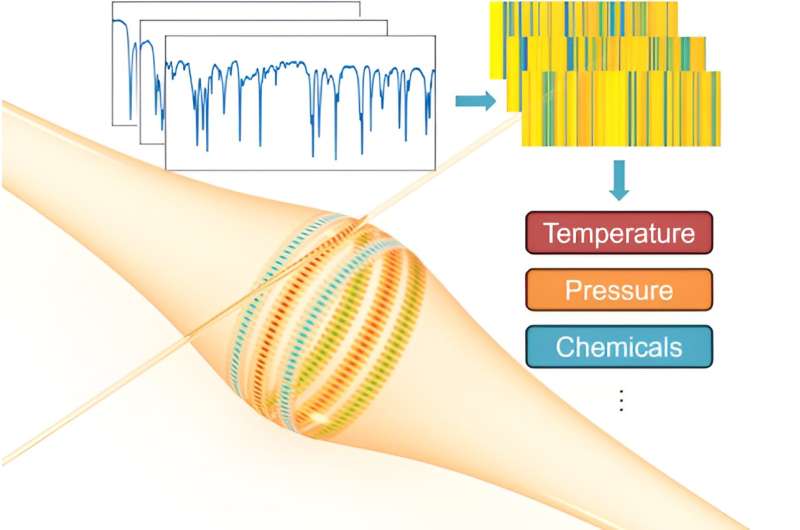Innovative optical sensing technology developed in the Yang Laboratory in the McKelvey School of Engineering utilizes multi-mode resonance to improve sensing capabilities. By analyzing patterns in the resonant spectrum, innovative barcoding technology provides detailed information about the sensor’s surroundings, providing enhanced dynamic range and accuracy in a variety of sensing applications.Image source: Yang Laboratory
The same geometric quirks that allow visitors to whisper messages around the circular dome of the Whispering Gallery of St. Paul’s Cathedral in London or through the echoing arches of St. Louis’ Union Station also enable the construction of high-resolution optical sensors. Whispering gallery mode (WGM) resonators have been used for decades to detect chemical signatures, DNA strands, and even single molecules.
Just like the structure of a sound gallery bends and focuses sound waves, WGM microresonators confine and focus light into a tiny circular path. This enables WGM resonators to detect and quantify physical and biochemical properties, making them ideal for high-resolution sensing applications in areas such as biomedical diagnostics and environmental monitoring.
However, the widespread use of WGM resonators is limited by their narrow dynamic range and limited resolution and accuracy.
In a recent study published in the journal IEEE Transactions on Instrumentation and MeasurementLan Yang, the Edwin H. & Florence G. Skinner Professor and postdoctoral researcher Jie Liao in the Preston M. Greene Department of Electrical and Systems Engineering at Washington University in St. Louis’ McKelvey School of Engineering, demonstrate a transformative approach to overcoming these limitations: using Optical WGM barcodes for multi-mode sensing.
Liao and Yang’s innovative technique allows simultaneous monitoring of multiple resonant modes within a single WGM resonator, greatly expanding the achievable measurement range by taking into account the unique response of each mode.
WGM sensing uses light of a specific wavelength that can circulate millions of times around the perimeter of a microresonator. When the sensor encounters a molecule, the resonant frequency of the circulating light changes. Researchers can then measure this transition to detect and identify the presence of specific molecules.
“Multimode sensing allows us to detect multiple resonant changes in wavelengths, not just one,” Liao explains. “With multiple modes, we can extend optical WGM sensing to a larger wavelength range, achieve higher resolution and accuracy, and ultimately sense more particles.”
Liao and Yang discovered the theoretical limit of WGM detection and used it to estimate the sensing capabilities of multimode systems. They compared traditional single-mode sensing to multi-mode sensing and determined that although single-mode sensing is limited to a very narrow range (about 20 picometers (pm)) by the laser hardware, using the same settings, the range of multimode sensing is potentially unlimited.
“More resonance means more messages,” Liao said. “While we were actually limited by the sensing equipment, we theoretically derived an infinite range. In this study, we found that the experimental limit of the new method is approximately 350 times greater than conventional methods of WGM sensing.”
Yang said commercial applications for multimodal WGM sensing could include biomedical, chemical and environmental uses. In biomedical applications, for example, researchers can detect subtle changes in molecular interactions with unprecedented sensitivity to improve disease diagnosis and drug discovery.
In environmental monitoring, multi-modal sensing can detect small changes in environmental parameters such as temperature and pressure, which can enable early warning systems for natural disasters or facilitate monitoring of air and water pollution levels.
The new technology also enables continuous monitoring of chemical reactions, as demonstrated by recent experiments conducted by Yang’s team. This capability promises to enable instantaneous analysis and control of chemical processes, providing potential applications in areas such as pharmaceuticals, materials science, and the food industry.
“The ultra-high sensitivity of WGM resonators allows us to detect single particles and ions, but the potential of this powerful technology has not been fully exploited because we cannot directly use this ultra-sensitive detector to measure completely unknown objects,” Liao added.
“Multimodal sensing allows us to explore the unknown. By expanding our dynamic range to observe millions of particles, we can take on more ambitious projects and solve real-world problems.”
More information:
Jie Liao et al., Multimodal Sensing of Optical Corridor Pattern Barcodes: A New Approach to Extending the Dynamic Range of High-Resolution Measurements, IEEE Transactions on Instrumentation and Measurement (2024). DOI: 10.1109/TIM.2024.3352712
Provided by Washington University in St. Louis
citation: Optical barcodes extend range of high-resolution sensors (April 26, 2024), Retrieved April 26, 2024, from https://phys.org/news/2024-04-optical-barcodes-range- high-resolution.html
This document is protected by copyright. No part may be reproduced without written permission except in the interests of fair dealing for private study or research purposes. Content is for reference only.
#Optical #barcodes #expand #range #highresolution #sensors
Image Source : phys.org
